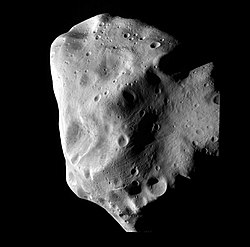21 Lutetia

Rosetta image of 21 Lutetia at closest approach
|
|
| Discovery | |
|---|---|
| Discovered by | Hermann M. S. Goldschmidt |
| Discovery date | November 15, 1852 |
| Designations | |
| Pronunciation | /ljuːˈtiːʃə/ |
|
Named after
|
Paris (Latin: Lutētia) |
| Main belt | |
| Orbital characteristics | |
| Epoch January 30, 2005 (JD 2453400.5) | |
| Aphelion | 2.834 AU (423.955 Gm) |
| Perihelion | 2.036 AU (304.600 Gm) |
| 2.435 AU (364.277 Gm) | |
| Eccentricity | 0.164 |
| 3.80 a (1387.902 d) | |
|
Average orbital speed
|
18.96 km/s |
| 75.393° | |
| Inclination | 3.064° |
| 80.917° | |
| 250.227° | |
| Physical characteristics | |
| Dimensions | (121± 1) × (101 ± 1) × (75 ± 13) km |
| Volume | 5.0 ± 0.4×1014 m³ |
| Mass | 1.700 ± 0.017×1018 kg |
|
Mean density
|
3.4 ± 0.3 g/cm³ |
| ~0.049 m/s² | |
| ~0.069 km/s | |
| 0.3402 d (8.1655 h) | |
| 96° | |
|
North pole right ascension
|
51.8 ± 0.4° |
|
North pole declination
|
+10.8 ± 0.4° |
| Albedo | 0.19 ± 0.01 (geometrical) 0.073 ± 0.002 (bond) |
| Temperature | 170–245 K |
|
Spectral type
|
M (Tholen) |
| 9.25 to 13.17 | |
| 7.29 | |
21 Lutetia is a large asteroid in the asteroid belt of an unusual spectral type. It measures about 100 kilometers in diameter (120 km along its major axis). It was discovered in 1852 by Hermann Goldschmidt, and is named after Lutetia, the Latin name of Paris.
Lutetia has an irregular shape and is heavily cratered, with the largest impact crater reaching 45 km in diameter. The surface is geologically heterogeneous and is intersected by a system of grooves and scarps, which are thought to be fractures. It has a high average density, meaning that it is made of metal-rich rock.
The Rosetta probe passed within 3,162 km (1,965 mi) of Lutetia in July 2010. It was the largest asteroid visited by a spacecraft until Dawn arrived at Vesta in July 2011.
Lutetia was discovered on November 15, 1852, by Hermann Goldschmidt from the balcony of his apartment in Paris. A preliminary orbit for the asteroid was computed in November–December 1852 by German astronomer Georg Rümker and others. In 1903, it was photographed at opposition by Edward Pickering at Harvard College Observatory. He computed an opposition magnitude of 10.8.
There have been two reported stellar occultations by Lutetia, observed from Malta in 1997 and Australia in 2003, with only one chord each, roughly agreeing with IRAS measurements.
...
Wikipedia
